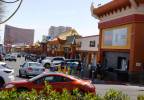Bitter Springs Trail a rugged but rewarding route
The sprawl of urban Las Vegas may be just over the horizon, but you are far from civilization when you follow the Bitter Springs Trail south of Valley of Fire State Park.
This little-known part of Southern Nevada remains nearly as uncivlized as it was when Las Vegas was settled more than a century ago.
Designated a Backcountry Byway and marked by the Bureau of Land Management, the scenic trail appeals to off-pavement explorers, campers, picnickers, hikers, mountain bikers, horsemen and photographers.
The challenging 28-mile route links old mining roads and washes through the Muddy Mountains between Interstate 15 and the highway around Lake Mead near Echo Bay. The drive will take about two hours, longer if you stop to explore.
To reach the byway, drive north on I-15 to the Valley of Fire exit, about 35 miles from downtown. Follow the paved park road east about 2½ miles to where the paved road swings to the left and a graded road forks right, pointing toward dark mountains ahead.
Head east into the foothills. Severely washboarded, the graded road forces drivers to slow down and choose the smoothest place to drive, often the shoulders of the road.
About a mile after leaving the park road, watch for an old road crossing your route. Part of the Old Spanish Trail, later known as the Mormon Trail, this route brought explorers, mountain men, traders and pioneers into Southern Nevada. Waterless for 60 miles until it reached the springs at Las Vegas, the trail took a toll on travelers, livestock and equipment.
Although the first few miles of the byway can be negotiated by passenger cars driven carefully, the remaining miles through a rocky mountain pass and down toward Lake Mead demand a high-clearance vehicle or even four-wheel drive.
Go only as far as you feel comfortable, then park off the road, enjoy a picnic and explore on foot. You will be close to multicolored sandstone formations known as Buffington Pockets, similar to landscapes in the Valley of Fire. Campers often set up primitive campsites in this beautiful area or park self-contained RVs.
Ancient native people, attracted to the area by a few springs or water-filled potholes, hunted animals and gathered plants for food, medicine and other uses. They left their marks on the area’s boulders and rock faces in the form of petroglyphs and pictographs and on the landscape with their anthill-shaped roasting pits. Look for rock art on some boulders and on canyon walls.
Frontier settlement brought mining ventures. Someone sought to enhance the water sources with a concrete dam against a cliff to catch runoff. The byway passes the remains of old borax works and an area where colorful sandstone was quarried. When exploring, watch for cisterns or shafts and stay out of mine tunnels.
The Bitter Springs Trail crawls through the pass over rocks and ledges exposed by flash floods. Respect areas posted as wilderness. Below the pass, the desert is cut by deep washes that are treacherous with sandy or gravelly stretches. Where the adventurous trail reaches Bitter Spring, expect mud from runoff.
The BLM marks the designated Backcountry Byway with distinctive narrow brown signs bearing the agency’s emblem. The BLM is not generous with these signs, so watch closely or you will overlook them. They are found at road forks and at widely spaced intervals.
At one deep wash, the route crosses and makes an unexpected turn to the left, doubling back and seeming to run the wrong way. Follow it anyway, and you will eventually see another sign. The byway returns to pavement through the big wash that leads to Echo Bay or, on a longer, rougher leg of the trail, on the highway west of the rock formations known as Redstone.
For safety’s sake, let someone know where you are going and when you expect to return. Take a cellphone. Use a detailed map. Dress in layers and wear sunscreen. Carry at least a gallon of water per person and some snacks.
Margo Bartlett Pesek’s Trip of the Week column appears on Sundays.




























